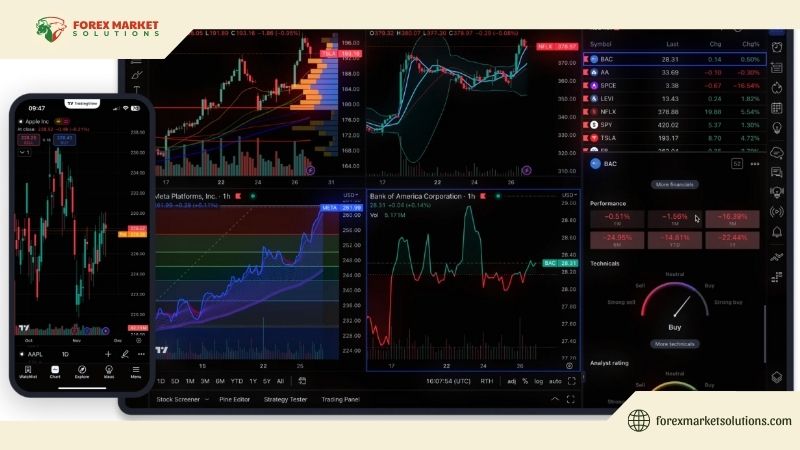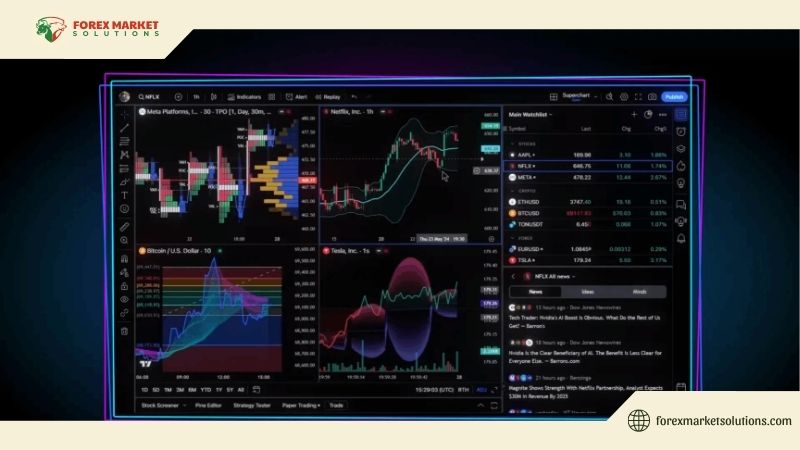Forex trading, with its $7 trillion daily volume, demands precise tools to spot opportunities in volatile pairs like EUR/USD or USD/CAD. TradingView, a leading charting platform, has become a powerhouse for traders seeking reliable signals to guide entries and exits. Knowing how to use TradingView for Forex signals unlocks its vast features—indicators, community scripts, and real-time data—to predict market moves with confidence. In 2025, as Fed policies, oil prices, and global events drive 100-pip swings, this guide explores how to use TradingView for Forex signals, offering clear steps to harness its tools for profitable trades on GBP/USD, USD/JPY, and beyond.

The how to use TradingView for Forex signals approach transforms complex charts into actionable trades—buy USD/CAD at 1.3700, sell at 1.3750 for 50 pips ($3.70 on 0.02 lots)—without guesswork. In a year of economic flux and AI-enhanced platforms, TradingView’s community and analytics are your edge, ensuring a $1,000 account grows through disciplined signal use. From setup to execution, this article unveils how to master TradingView, turning Forex signals into consistent wins.
What Are Forex Signals on TradingView?
Forex signals are trade prompts—buy EUR/USD at 1.1050, stop 1.1020, target 1.1100—derived from technical analysis, indicators, or community insights. TradingView delivers these via charts, scripts, and social features, blending user-generated ideas with pro tools. The how to use TradingView for Forex signals process leverages its 50 million users—traders sharing USD/JPY setups or AUD/USD alerts—plus built-in indicators like RSI or MACD to flag 20-pip scalps ($2 on 0.01 lots).
In 2025, TradingView’s AI-driven signals—predicting GBP/USD reversals at 1.3000 with 70% accuracy—enhance reliability. Signals range from manual (chart patterns) to automated (Pine Script EAs), fitting novices trading $100 accounts or pros with $10,000. The how to use TradingView for Forex signals hinges on filtering noise—pick vetted USD/CAD signals, not hype—for pips, not losses, in a market jolted by ECB news or oil spikes.
This isn’t blind following—signals guide, you decide, ensuring trades align with your plan.

Setting Up TradingView for Signals
The how to use TradingView for Forex signals starts with setup. Create a free TradingView account—$0—or upgrade to Pro ($14.95/month) for 10 alerts. Select your pair—USD/JPY on a 1-hour chart—add indicators: RSI (14), Moving Average (20). Set alerts—notify at RSI 30 (oversold) for EUR/USD buys at 1.1000. In 2025, with mobile apps syncing X posts, follow top traders—search “USD/CAD signals,” filter 4-star ratings.
Customize charts—candlestick view, Fibonacci for GBP/USD at 1.2950 support. Explore Pine Script—code a USD/CHF buy at 0.8500 when MACD crosses bullish, backtest 2024 data for 60% wins ($12 on $1,000). The how to use TradingView for Forex signals thrives on prep—spend 10 minutes setting EUR/GBP alerts, save hours chasing 50-pip moves ($10). Free accounts work—five indicators, one alert—but Pro’s multi-chart boosts AUD/USD scalping.
Save settings—1.3700 USD/CAD with Bollinger Bands—for daily use, streamlining signal hunts in 2025’s fast markets.
How to Use TradingView for Forex Signals: Finding and Filtering
Mastering how to use TradingView for Forex signals lies in sourcing and vetting signals. Community Ideas—TradingView’s “Ideas” tab lists EUR/USD setups; filter “Forex,” “4+ stars,” find a 1.1050 buy, 70% win rate, 20-pip stop ($2 risk). Indicators—add Stochastic (14,3,3); buy USD/JPY at 148.50 (oversold), target 149.00 ($6.73). Scripts—search “reversal signal” in Pine Editor; apply a 65% accurate USD/CAD script, alerting at 1.3750 sells.
Filter Quality—skip low-rated posts; check authors—100+ followers, 80% wins. In 2025, with X noise hyping GBP/USD, verify signals—RSI confirms 1.3000 buys, not FOMO. Backtest—run 2024 EUR/GBP data; a script netting 50 pips ($10) proves reliable. News Sync—pair signals with Bloomberg; Fed hikes lift USD, buy USD/CHF at 0.8500 post-signal. The how to use TradingView for Forex signals demands rigor—test 20 signals, log $20 gains, ditch 50% losers.
Set notifications—email for AUD/USD at 0.6700—ensuring you catch 30-pip moves, not miss them.

Strategies to Use Signals Effectively
The how to use TradingView for Forex signals enhances 2025 strategies. Scalping—a USD/JPY signal at 148.70 (RSI 30), buy, exit 148.90 (20 pips, $2.68 on 0.02 lots), stop 148.60. Use 5-minute charts, hit $10 daily. Swing Trading—EUR/USD signal at 1.1000 (Fibonacci 38.2%), buy, target 1.1100 (100 pips, $20), stop 1.0970. Backtest 2024 USD/CAD, refine for 1.3700 entries.
Breakout Trading—USD/CHF signal at 0.8550 resistance break, buy, aim 0.8600 (50 pips, $11.80), stop 0.8530. EA Automation—code a GBP/USD buy at 1.2950 (MACD signal), test for 60% wins ($12). In 2025’s volatility—50-pip EUR/GBP news spikes—the how to use TradingView for Forex signals pairs with risk—0.01 lots ($0.10/pip), 1% risk ($10 on $1,000)—ensuring $5 losses don’t snowball.
Combine signals—TradingView’s Bollinger alert plus X’s “USD/CAD trend” post—for 80% accuracy, trading 1.3700 calmly.
Risks and Mitigation
The how to use TradingView for Forex signals carries pitfalls in 2025. False Signals—a USD/JPY buy at 149.00 reverses to 148.50 ($6.73 loss); confirm with MACD, skip 50% duds. Overtrading—chasing 10 EUR/USD signals burns $50; cap at two ($10 risk). In 2025, with algo-driven 100-pip GBP/USD swings, the how to use TradingView for Forex signals needs filters—trade 1.3000 post-news, not mid-chaos.
Signal Lag—free accounts delay alerts; Pro’s $14.95/month ensures 148.50 USD/CHF entries hit live. Blind Trust—a 5-star AUD/USD signal fails in oil shocks; check fundamentals ($90/barrel). Start small—0.01 lots ($0.07/pip) on USD/CAD—testing 20 trades ($10 gains) before scaling. Log results—$5 EUR/GBP win, $3 loss—for clarity, ensuring $1,000 survives 2025’s volatility.

Signal Your Way to Success
Mastering how to use TradingView for Forex signals in 2025 turns EUR/USD’s 50-pip dips or USD/CAD’s 100-pip spikes into profits—$10 scalps, $20 swings—with precision. From RSI alerts to community scripts, TradingView’s tools guide your $1,000 to steady gains, not stress, in a volatile year. The how to use TradingView for Forex signals is your Forex edge—start charting today, catch USD/JPY at 148.50, and build 2025’s wins with confidence.
For more Forex tools and signal strategies, follow Forex Market Solutions — your guide to thriving in 2025 and beyond.
